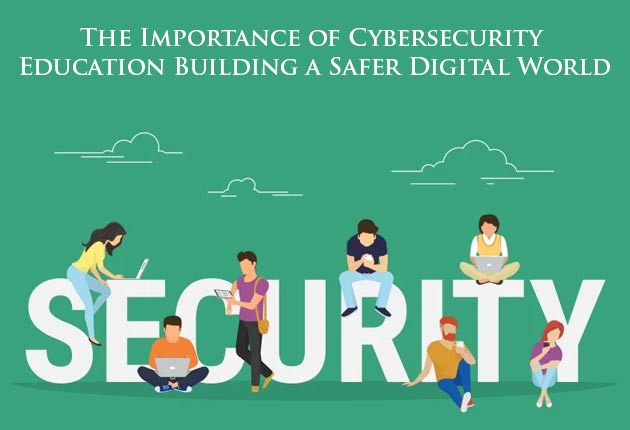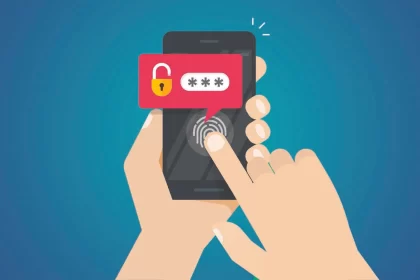Did you know cyberbullying is a big problem today? It can lead to very sad outcomes, like self-harm or even suicide. We need to teach our kids about cybersecurity. It helps them stay safe online and opens up chances for their future.
Attackers often target schools to steal data. They use ransomware, DDoS attacks, and more. As these attacks increase, so does the need for experts in cybersecurity. Students who learn about it can help stop these crimes. They also become very valuable in the job market. For schools looking to enhance their cybersecurity education and infrastructure, IT Support Los Angeles offers specialized services to protect and educate.
It’s important to teach cybersecurity in schools and colleges. Subjects like computer science and math can include it. This teaches students how to think critically and solve problems. They learn to spot and deal with cyber dangers.
Schools need to use strong security tools to keep everyone’s data safe. This includes things like encryption and multi-factor authentication. They also need to watch for threats and test for weak spots constantly.
Key Takeaways
- Cyberbullying’s severe impact accentuates the need for cybersecurity education.
- Demand for cybersecurity professionals is growing, offering a competitive advantage to knowledgeable students.
- Incorporating cybersecurity into curricula empowers students and enhances their critical thinking and problem-solving skills.
- Robust cybersecurity measures protect sensitive data in educational institutions.
- Advanced threat detection systems and continuous monitoring are crucial in combating cyber threats.
Introduction to the Role of Education in Cybersecurity
Today, our digital age faces threats like identity theft and cyberbullying. Cybersecurity education is crucial to combat these challenges. It teaches key skills to protect against cybercrime.
The cybersecurity scene today is battling advanced cyberattacks. These threats grow daily, preying on system weaknesses. The Cybersecurity and Infrastructure Security Agency (CISA) helps schools strengthen their cyber defenses. Programs like CyberPatriot provide vital training for budding cybersecurity experts.
Education plays a key role in improving cybersecurity knowledge and skills. Efforts by organizations like the National Initiative for Cybersecurity Education (NICE) push for strong cybersecurity curriculums. By adding cybersecurity lessons to school programs, students learn everything from safe web use to managing cyber incidents. This education creates a generation well-equipped to tackle cybersecurity challenges.
Integrating Cybersecurity into School and University Curricula
Bringing cybersecurity lessons into schools and colleges is critical for protecting our digital tomorrow. Only 45% of teachers surveyed say their students get cybersecurity instruction. This shows we need more education on this topic now.
Teaching kids about cybersecurity early on gives them important tools to avoid online dangers. While 91% of teachers know a bit about it, only 10% feel they know a lot. Starting lessons young can make the internet safer for everyone.
Programs and Initiatives Promoting Cybersecurity in Educational Institutions
There are many efforts to increase cybersecurity awareness in schools. The National Centers of Academic Excellence in Cybersecurity (NCAE-C) program sets high education standards. It partners with the NSA, CISA, and FBI to recognize schools with strong cybersecurity education.
Schools and colleges are essential in teaching cybersecurity through special classes and fun activities. In areas with good cybersecurity resources, students learn more. They’re better prepared for online challenges compared to those in less equipped places.
By adding strong cybersecurity lessons in schools, we get the next generation ready to face digital dangers. This approach helps them stay safe online and lays a solid foundation for their future careers.
Developing Effective Employee Training Programs for Cybersecurity Awareness
Creating cybersecurity training for employees is key to protecting businesses. Cybercrime costs could hit $23.84 trillion by 2027. It’s vital for companies to be ready.
Human mistakes cause 88% of security breaches. This shows why ongoing employee awareness is crucial. With cyber threats changing, such as phishing, staying updated is a must.
Different teams need different cybersecurity training. IT staff need technical know-how. Others should learn about phishing and basic security. Executives should understand risk and policy-making. The finance team must know about safe transactions.
Effective Methods and Tools for Cybersecurity Training
Many cybersecurity tools can make training better. Gamification keeps learners engaged with rewards. Adding quizzes, simulations, and practice tasks can also help.
It’s important to keep training materials fresh. Smaller, ongoing lessons help with memory. Also, VR, AI, and AR could change cybersecurity training soon, making it more effective.
Good cybersecurity training does more than save money. It builds a careful and responsible culture. This helps staff protect their company from cyber threats.
Public Awareness Campaigns: Raising Awareness to Prevent Cyber Threats
Public awareness campaigns are key in teaching people about online safety and risks. They help build a safer digital world by making everyone more careful and informed about cyber threats.
The work of the Cybersecurity and Infrastructure Security Agency (CISA) and the National Cybersecurity Alliance (NCA) highlights the value of teaching the public about cybersecurity. They work together to raise awareness globally. Thanks to their efforts, people learn ways to block cyber threats. The U.S. has celebrated Cybersecurity Awareness Month every October since 2004, showing its dedication to this cause.
Examples of Successful Awareness Campaigns and Initiatives
The CISA Cybersecurity Awareness Program focuses on making people aware of cyber dangers and how to stay safe online. The Homeland Security Information Network (HSIN) is another great tool. It helps protect critical areas by providing collaboration tools to both private and public sectors.
During Cybersecurity Awareness Month and Data Privacy Week in January, the National Cybersecurity Alliance encourages involvement through its Champion program. This program is free to join and offers plenty of resources. It helps spread the word about staying safe online to communities and workplaces all year round.
Certifications and Professional Development in Cybersecurity
Cybersecurity certifications show professionals are experts in digital security. Getting these certifications helps with career growth and recognition in the industry. They make professionals stand out.
The need for skilled cybersecurity people is rising. Some certifications are highly valued in this field. The CISSP certification leads with a high demand in job listings. CISA certification is also key, especially for IT audit roles. Furthermore, Security+ is very common, showing it’s an important start in IT security.
Certifications like CEH, CISM, and GSEC are also important. They focus on ethical hacking, security management, and essential security knowledge. These certifications need tough training and exams. This ensures certified pros know the latest in cybersecurity.
Benefits of Certification for Career Growth and Industry Recognition
Having a cybersecurity certification can take your career to new heights. For example, CISSP holders can become Chief Information Security Officers, earning up to $193,081. CISA and CISM certifications also lead to well-paying jobs. Positions like IT Audit Manager and Director of Information Security offer hefty salaries.
Certifications mean you’re always learning and keeping up with cybersecurity. Programs like CyberSkills2Work focus on security for critical infrastructure. The CyberCorps®: Scholarship for Service program helps students get degrees in cybersecurity. This shows the industry’s effort to build talent.
In conclusion, cybersecurity certifications boost professional growth and recognition. They prove your skills and dedication to maintaining cybersecurity standards. These credentials are vital in today’s tech world.
Building Collaborations and Partnerships to Enhance Cybersecurity Education
The world of cybersecurity is always changing, calling for new ways of learning. Partnerships between companies and schools can help build cutting-edge and useful programs.
Working together, schools and companies can meet today’s cybersecurity challenges. Take the example of the University at Albany’s cyber defense center, backed by the NSA. Such partnerships share vital skills and keep teaching up-to-date with cybersecurity trends.
Collaborative Efforts to Promote and Enhance Cybersecurity Education
Teamwork in cybersecurity education is key to creating skilled professionals. Through global team-ups, like those with Interpol and Europol, we see the sharing of knowledge and joint training. These moves improve skills and drive innovation.
Groups like PACET join forces with government, business, and schools. They help make sure future graduates can handle new cybersecurity challenges.
Future Trends in Cybersecurity Education: Emerging Technologies and Teaching Methods
The world of cybersecurity education is changing fast. New technologies and teaching methods are coming into play. In 2023, 71% of organizations said the lack of cybersecurity staff has hurt them a lot. We need to look ahead and get ready for changes in how we teach cybersecurity.
New technologies like artificial intelligence (AI) and machine learning (ML) are shaping cybersecurity education. They help in finding and stopping cyber threats. They also prepare students for real cybersecurity work by teaching them through practice.
Cloud computing is creating new cyber risks. This is because of how cloud security is shared between users and providers. Cybersecurity courses must cover this to prepare students well. As companies rely more on security services, schools must update their cybersecurity education to keep pace.
For businesses facing these new challenges, Managed IT Services Los Angeles offers specialized expertise to navigate and mitigate cloud-related cyber risks. These services ensure that companies maintain robust security measures and stay updated with the latest cybersecurity practices, allowing them to operate safely in the cloud environment.
Preparing the Next Generation of Cybersecurity Professionals
To prepare future cybersecurity experts, we need to teach them to think ahead. They need skills to deal with changing cyber threats. Training them with real-world simulations and advanced tools is vital.
New laws like GDPR and the growth of IoT Security and 5G networks bring new challenges. Cybersecurity courses must include these topics. This will make the education relevant and complete.
By using new and adaptive teaching methods, we can close the cybersecurity skills gap. This will ensure we have professionals ready to protect our digital world in the future.
Conclusion: Emphasizing the Role of Education in Building a Safer Digital World
The digital world faces growing threats from cyber-attacks, highlighting the need for cybersecurity education. Attacks on schools alone have risen by 84% in just six months. This shows the urgent need for strong cybersecurity measures.
Schools face threats like phishing, malware, and ransomware. To tackle these, commitment to cybersecurity education at every level is essential.
We’ve shown how cybersecurity education creates a safer digital world. We started with the current state of cyber threats and stressed the need for cybersecurity in school subjects. Teaching students and staff about cyber safety helps schools bounce back from attacks quickly.
Public campaigns also reduce cyber risks. Working together with the industry and getting certifications are key. We’ve seen how constant updates and strong passwords are critical. Indeed, education is at the heart of cybersecurity.
Committing to cybersecurity at all levels makes our digital world stronger. This education is vital for protecting data and ensuring online safety. Training future professionals and using new technologies are crucial for a secure digital future.
By educating everyone, we can work towards a more secure future. As cyber threats evolve, education remains key in creating a fortified digital environment.










